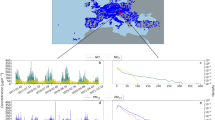Abstract
We develop a physically motivated statistical model for regional ozone air pollution by separating the ground-level pollutant concentration field into three components, namely: transport, local production, and large-scale mean trend mostly dominated by emission rates. The model is novel in the field of environmental spatial statistics in that it is a combined deterministic-statistical model, which gives novel perspectives on the modeling of air pollution. The model is presented in a Bayesian hierarchical formalism, and explicitly accounts for advection of pollutants, using the advection equation. We apply the model to a specific case of regional ozone pollution – the Lower Fraser Valley of British Columbia, Canada. As a predictive tool, we demonstrate that the model outperforms existing, simpler statistical modelling approaches. Our study highlights the importance of simultaneously considering different aspects of air pollution as well as taking into account the physical bases that govern the processes of interest.
Access this chapter
Tax calculation will be finalised at checkout
Purchases are for personal use only
Similar content being viewed by others
References
Berliner LM (2003) Physical-statistical modeling in geophysics. J Geophys Res 108(D24):8776
Box G, Jenkins G (1976) Time series analysis forecasting and control. Holden-Day, Inc., San Francisco
Burrows WR, Benjamin M, Beauchamp S, Lord ER, McCollor D, Thomson B (1995) CART decision tree statistical analysis and prediction of summer season maximum surface ozone for the Vancouver, Montreal, and Atlantic Regions of Canada. J Appl Meteorol 34:1848–1862
EPA AQCD (2006) Air quality criteria for ozone and related photochemical oxidants: U.S. Environmental protection agency. Washington, DC, EPA/600/R-05/004aF-CF
Guillas S, Tiao G, Wuebbles D, Zubrow A (2006) Statistical diagnostic and correction of a chemistry-transport model for the prediction of total column ozone. Atmos Chem Phys 6:527–537
Huang HC, Hsu NJ (2004) Modeling transport effects on ground-level ozone using a non-stationary space–time model. Environmetrics 15:251–268
Huerta G, Sanso B, Stroud JR (2004) A spatiotemporal model for Mexico City ozone levels. Appl Stat 53(2):231–248
Kalenderski S (2009) Stochastic modelling of space-time processes: an air pollution problem. VDM Verlag, Saarbrücken. Available from http://hdl.handle.net/2429/7457
McKendry IG (2002) Evaluation of artificial neural networks for fine particulate pollution (PM10 and PM2.5) forecasting. J Air Waste Manage Assoc 52:1096–1101
Metro Vancouver (2007) Lower fraser valley air quality report. p 35
Robeson SM, Steyn DG (1989) A conditional probability density function for ozone air quality data. Atmos Environ 23:689–692
Royle JA, Berliner LM (1999) A hierarchical approach to multivariate spatial modeling and prediction. J Agric Biol Environ Stat 4:29–56
Wikle CK, Berliner M, Cressie N (1998) Hierarchical Bayesian space-time models. J Environ Ecol Stat 5:117–154
Author information
Authors and Affiliations
Corresponding author
Editor information
Editors and Affiliations
Rights and permissions
Copyright information
© 2011 Springer Science+Business Media B.V.
About this paper
Cite this paper
Kalenderski, S.D., Steyn, D.G. (2011). Mixed Deterministic-Statistical Modelling of Regional Ozone Air Pollution. In: Steyn, D., Trini Castelli, S. (eds) Air Pollution Modeling and its Application XXI. NATO Science for Peace and Security Series C: Environmental Security. Springer, Dordrecht. https://doi.org/10.1007/978-94-007-1359-8_57
Download citation
DOI: https://doi.org/10.1007/978-94-007-1359-8_57
Published:
Publisher Name: Springer, Dordrecht
Print ISBN: 978-94-007-1358-1
Online ISBN: 978-94-007-1359-8
eBook Packages: Earth and Environmental ScienceEarth and Environmental Science (R0)




